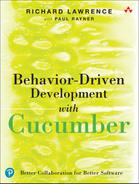Chapter 9
Conclusion
By now, you’ve gotten a glimpse into what it looks like for a typical Agile team to get started with BDD. You’ve seen the differences between good and bad scenarios. You’ve learned how to take your first steps toward automating scenarios, and you’ve seen some of the challenges you can anticipate as you become more advanced— organizing a large suite of scenarios and dealing with complicated scenario data. Better yet, you know some strategies for overcoming those challenges.
If you’ve already started with BDD as you’ve read the book, we hope you’ve begun to experience a different kind of collaboration, with multiple roles working together around concrete examples to build just the right behavior for your customers. Remember to keep that focus on collaboration first and test automation a distant second.
If you’re about to get started, remember the slow lane from Chapter 2, “Exploring with Examples.” You don’t need to change everything at once. Just pick a single user story to practice with each sprint. Slowly learn how to do BDD well in your context, and then expand. Take your time.
If even that sounds overwhelming, start even smaller: Just use examples more in your conversations about your product. That one simple practice will make your collaboration better. Automation can come later.
Thanks for reading. Go make great software together!
